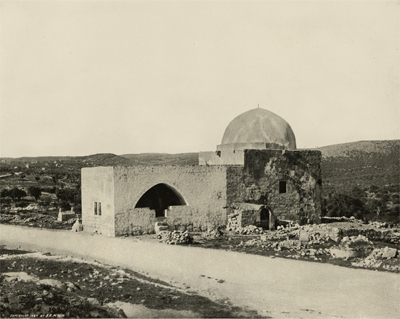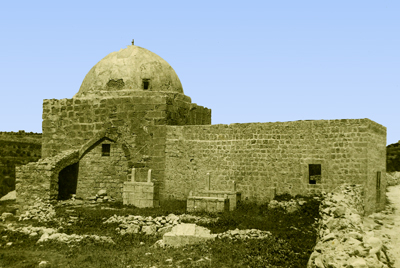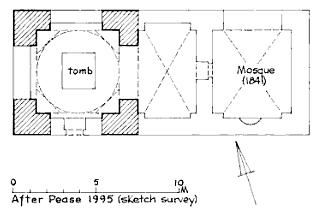In response to my previous post, Joe Zias, physical anthropologist, who worked for many years for the Israel Antiquities Authority, wrote concerning Rachel’s Tomb:
Check out photographs at Yad Ben Tsvi lib. to see Islamic graves surrounding the site up to and abutting the shrine. I in fact was called in to view burial remans just a few meters to the north of the entrance which lie under the pavement in which all and everyone walks across. they were Islamic according to their orientation and no more than a few hundred yrs old. Haredim were satisified that they were not Jewish and covered up the remains (so they said).
There certainly has been a Muslim graveyard next to Rachel’s Tomb for the last few hundred years. See pics below. However, a cluster of Muslim tombs does not a Muslim site make. The exterior of the eastern wall of the Temple Mount is lined with Muslim tombs, but we know a lot more about its history than that fact. Rachel’s Tomb is not just the tomb of an insignificant female character from the Bible, but of Rachel, who the Jews call Imeinu, “Our mother”, wife of Jacob, the third Jewish patriarch. The site of her tomb is noted twice in Scripture: Gen. 35.16-20 and 1 Sam. 10.2 and by numerous early pilgrims to the Holy Land.

The Muslims, who walked into history more than 2,500 years later, also revere Rachel and her name appears in the Koran. It is because of that association that her tomb became a popular “wely” or site to hold funerals.

And when Moses Montefiore bought the site for the Jews in 1841, he built a vaulted vestibule for the Muslims to pray in, in order to conciliate them. Denys Pringle in his comprehensive historical note to the site in The Churches of the Crusader Kingdom of Jerusalem, (written in 1995, with no political axe to grind) provides a sketch plan of how this building relates to the tomb.

It is difficult to see how this Muslim reverence for Rachel translates into the recent renaming of the structure, the Bilal bin Rabah Mosque, after an Ethiopian Muslim believed to be the first muezzin! This rewriting of history is heading up for one more battle in the conflict over the Holy Places. It reminds me of the statement of a Muslim tour guide who we once employed to show us round the Temple Mount, in order to get their perspective. He told us, in all seriousness: “Melchizedek was the first Palestinian king of Jerusalem!

Just read an article that is very thorough on the subject of Rachel’s Tomb and thought I would pass along to your readers. http://www.jidaily.com/yOzMk/e
Thanks Daniel,
Wrote a blog yesterday, mentioning Israeli commentators on the right of the political spectrum, who insist on the historicity of Rachel’s Tomb, e.g. Nadav Shragai who does a very thorough job, while others on the left don’t seem to care, doubting if Rachel ever existed. Have a look at the maps on the latest blog and let me know what you think.